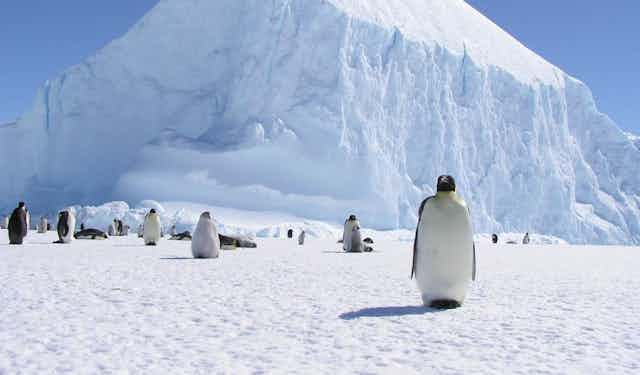The Australian government’s blueprint for the Antarctic is due out soon. Given the recent cuts in public funding for science, what hope is there for any extra monies for the polar region. And what should Australia’s future be in Antarctica?
Tony Press, ex-director of the Australian Antarctic Division (AAD), was commissioned last October to review Australia’s Antarctic engagement and to develop a 20-year Australian Antarctic Strategic Plan. It’s due to be delivered to the Environment Minister Greg Hunt in the coming weeks.
Many aspects of our Antarctic commitment will be covered, including the strategic importance of our Antarctic interests, transport to and within the continent and Australia’s commitment to globally relevant science, to name a few.
Australia claims some 42% of the Antarctic continent and since 1929 the Australian government has supported scientific research expeditions to the great southern land.
In 1947 these expeditions were formalised as the Australian National Antarctic Research Expeditions (ANARE) and in 1948 the Australian Antarctic Division (AAD) was established within the Department of External Affairs.
Others are interested in the region
The AAD resides within the Department of the Environment and ostensibly Australia’s primary activity in Antarctica revolves around science. But our claim weighs heavily and discussion on Australia’s role in Antarctica is evolving.

Nations such as China and India look to the vast southern continent as a resource to be examined and perhaps exploited in time to come.
The stratego-political relevance of Antarctica is evidenced by the British Antarctic Survey sitting under the UK’s Foreign and Commonwealth Office (FCO). The United States Antarctic Program’s first mission is to maintain an active and influential presence in Antarctica that supports the range of its interests under the Antarctic Treaty.
To substantiate our claim, it is recognised that Australia must do more than dally with science upon the continental fringes. We must get serious about waving our flag across the interior.
But implementation of any plan requires funding. Recent cuts mean that Australia’s cry as a leader in polar science rings hollow. Our Antarctic infrastructure is ageing and limited funds remain to fund spatially extensive, world-leading science.
Who’s got the money?
So, without sufficient government funding, how else might wide-ranging Antarctic science be conducted?
Polar science is expensive. The poles are far removed from established transport routes and distances are vast. Is reliance upon expensive government infrastructure and institutions necessary?
Privately funded scientific expeditions and non-government-funded university scientists appear sidling in to fill this space, typically via lighter, cheaper and possibly more efficient means.
Damien Gildea is an Australian scientist-mountaineer and between 2001 and 2008 he coordinated measurement of numerous unclimbed Antarctic peaks resulting in a new 1:50,000 colour topographical map of Vinson Massif and The Sentinel Range. The Omega Foundation provided private funding.

Over the period 2009-2011 the Catlin Arctic Survey gathered glaciological and oceanographical data across the frozen Arctic Ocean, ranging from northern Canada and Greenland to the pole. I was the scientist on the 2011 survey (pictured, above).
Aberystwyth University’s Alun Hubbard has spent the past five Arctic summers obtaining glaciological data from the Petermann Glacier in northern Greenland. His base, his vessel Gambo, is manned by a crew of volunteers or occasional scientists.
Dr Hubbard has some typical grant support, but his focus is obtaining scientific data via efficient and innovative means – means probably beyond those typically embraced by conservative government agencies.

Shortly, I expect to depart for the South Pole on the privately funded Outer Edge Polar Challenge. A towed ice-penetrating radar will gather thickness data across never-before-surveyed expanses of the Antarctic continent.
What do these examples have in common? They’re not funded by government, they employ lightweight, efficient transport methods and increasingly they’re not just adventures upon which science is “tacked on”.
The deinstitutionalisation of science generally and the advent of citizen science and crowdfunding such as Petri Dish is aligning with the advent of technological change.
Cheap robotic vehicles can carry lightweight instrumentation. Access to both polar regions can be attained via a growing number of private operators. The need for government support is diminishing.
As Damien Gildea told me recently:
The data does not know who funded you. It is quite possible, and not necessarily undesirable, that the future of Antarctic scientific research is private, not government.
Australia must maintain a strong presence in Antarctica and private science will face difficulties; the case of the MV Akademic Shokalskiy remains fresh.
But with adequate compulsory insurance (such as mandated by the UK’s Foreign and Commonwealth Office for all UK Antarctic expeditions), additional expense need not be transferred to the taxpayer should mishap or accidents occur.
Australia’s Antarctic people and institutions have served us well. But Tony Press’s report should serve as a catalyst for discussion, both on waving our flag and getting more bang from our polar science buck.

